SYSTEM
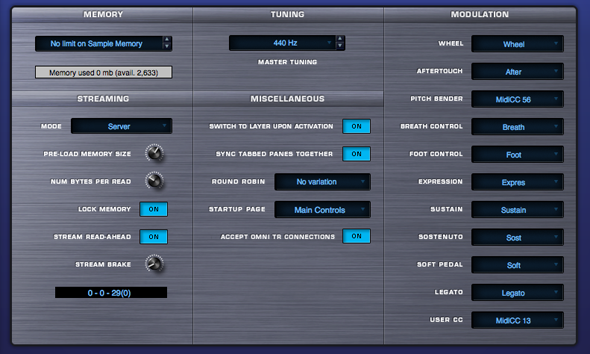
The System page in Omnisphere is a universal control area that governs how Omnisphere’s sounds are streamed, set some user defaults and configures the modulation controls.
SYSTEM

The System page in Omnisphere is a universal control area that governs how Omnisphere’s sounds are streamed, set some user defaults and configures the modulation controls.
SYSTEM - Memory Management

The Sample Memory Menu allows you to manually limit the amount of virtual memory Omnisphere can use for Sample Memory.
The default is ‘Process limit’. To disable memory limit alerts, use ‘No limit on Sample Memory’ instead.
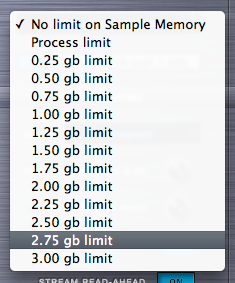
Selecting a value from the drop-down menu sets the maximum amount of virtual memory Omnisphere will have available to use.
Using the up-down steppers will step through the available values
NOTE: Omnisphere Soundsources can require a great deal of memory. When limiting the amount of memory available to Omnisphere, it is a good idea to also apply Sample Thinning using the Patch Browser Lite Version feature, or the thinning options on the Soundsource Zoom Edit View.
Memory Meter
The Memory Meter displays the amount of memory currently in use by Omnisphere, along with the remaining available memory. This display mirrors the Memory Gauge found on the Browser Pages.
![]()
NOTE: When Server Mode (Mac only) is enabled, the Sample Memory Menu will show "No limit on Sample Memory”. This is correct for Server Mode. The Memory Meter will always display “Memory used 0 mb”, but will continue to display your remaining available memory.
SYSTEM - Streaming
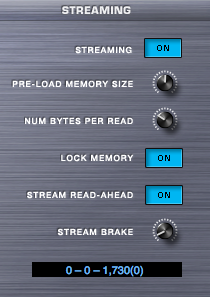
The first column contains controls for the streaming function in Omnisphere. Streaming permits samples to largely reside on disk. In this way you can use large samples with a relatively small amount of memory.
Streaming Swtich
![]()
This button engages or disengages drive streaming in Omnisphere. If you disable disc streaming your sounds will take longer to load and will take up more RAM.
It’s recommended to leave streaming ON unless you know what you are doing (e.g. have lots of physical memory) or need to disable hard drive streaming.
NOTE: On the Mac version of Omnisphere, the Streaming Switch is replaced by a Mode menu, which adds a Sample File Server as an alternative to using 64-bit hosts.
Pre-Load Memory Size
![]()
Determines how much memory is devoted to sample pre-load. The higher the settings, the less likely that glitches will occur due to streaming problems. However, turning it up requires more memory and will increase the load time for Soundsources.
Recommended values are between 22,000 to 66,000, with 60,000 as the standard default value. If patches make use Timbre or Sample-Start, this parameter might need to be raised over 40,000.
NOTE - Soundsources must be reloaded when changing this parameter before the new value will take effect.
Range - 1000 samples to 100,000 samples
Num Bytes Per Read
![]()
Determines the size of each read of sample data. Increasing this setting improves performance when working with a small number of large samples. The recommended setting is around 150,000. This parameter is generally not as important as the Pre-Load Memory Size. Values smaller than 100,000 should be avoided.
Range - 1000 Bytes to 480,000 Bytes
Lock Memory
![]()
Determines if RAM is dedicated to holding the Pre-Load memory. Lock Memory should be kept on except for rare cases where RAM is unavailable for this purpose (such as running many large applications simultaneously.) Soundsources must be reloaded when changing this parameter before it will take effect.
Stream Read-Ahead
![]()
This switch increases low-level disc read-ahead so fewer physical disc head movements are needed to perform several consecutive read actions. Since Stream Read-Ahead improves efficiency in almost all situations it should be left on.
Stream Brake
![]()
The control balances system resources between streaming and other operations. This is the second most important streaming parameter, after the Pre-Load Memory Size. It should generally be set to a moderate value around 0.1. Values above 0.5 may lead to streaming glitches due to deferring streaming reads in order to give priority to other processing operations in the application. Turning it down to zero may cause glitches in other operations due to the streaming monopolizing the CPU. There is a relationship between this parameter and the Num Bytes Per Read parameter. When that parameter is turned up, this parameter should generally also be turned up.
Range - 0.00 seconds to 1.00 seconds
Stream Display
![]()
Left number - The number of streams in progress. Should normally be zero, but should flash temporarily to a non-zero number when a note is started. If it stays non-zero for several seconds, that may be a problem, and so reducing the Brake (or increasing the PreLoad) would be recommended.
Middle number - The number of notes in progress. Should be zero when no notes are playing. May be a 2x or 4x multiple of the number of notes when doing velocity cross fading, or when there are multiple layers.
Right number - The number of samples that are "pre loaded" (including all voices in all parts). Should go up and down as various SoundSources are loaded. It may "lag" a bit behind load actions, which is normal.
Right number in parenthesis - number of samples loaded in "Streaming = OFF " mode. Should always be zero unless Streaming is turned off. An error is indicated by the streaming status display at the bottom of the left column on the system page when you see two numbers at the end of the display;
![]()
SYSTEM - Sample File Server

On the Mac version of Omnisphere, the Streaming Switch is replaced by the Mode menu, and provides an additional Server mode for loading sample data.
NOTE: The Server mode only works on Mac, so you wont see the Mode menu on Windows. On Windows, use a 64-bit host instead.
Server mode is a way of solving the "out of memory" problem that can happen when using large sample sets with 32-bit hosts and is an alternative to using 64-bit hosts. The Server mode should be used when you are running a 32-bit host on Mac, and you are loading large samples. If you are running a Mac 64-bit host (such as Logic 9.1 or higher), it is not necessary to enable Server mode.
NOTE: The Sample File Server uses physical RAM to load samples, and a minimum of 6GB of RAM is recommended when using Server Mode, especially when loading larger Keyswitch Multis.
The Streaming Mode Menu contains three items: Streamed, Not Streamed, and Server. Streamed and Not Streamed enable and disable Streaming. Select the Server option to enable the Sample File Server.
![]()
![]()
![]()
When Server is enabled, a new system process is created (in addition to the host process) called SpectrasonicsServer. It will appear in the Mac Activity Monitor. Omnisphere starts and stops that process automatically, so you should never have to worry about it.
NOTE: Server mode uses streaming internally, so the remaining stream-related controls in the Streaming section are still applied and useful when in Server mode.
SYSTEM - Miscellaneous Introduction

This area determines the settings for master tuning, the instrument’s startup page and preferences for how the Layers behave in the interface.
Startup Page Preference
![]()
Omnisphere’s default startup page is the Main Page. This menu allows you to set either the Main Page or the Edit page as the startup page.

Switch To Layer Upon Activation Preference
![]()
The Layer MIX sliders on the EDIT page have activation buttons below them. If Switch To Layer Upon Activation is set to “ON”, then whenever you turn on a Layer, it will automatically switch the EDIT page’s view to that Layer.

For example, if Layer A is activated, but Layer B is not, and you select the Layer B activation button, the EDIT page’s view will switch to Layer B.
This is the default behavior and the way that Atmosphere worked. If you prefer to not have the automatic Layer switching, you can turn that behavior off here.
If Switch To Layer Upon Activation is off, then Layer activation will not cause the Edit page to change to the activated Layer.
Sync Tabbed Panes Together
![]()
When enabled, this function will ensure that when you change from one Part to a different Part, the view will be the same.
For example, if Part1 has the FX page selected, and then Part2 is selected, it will also display the FX page. If Sync Tabbed Panes Together is disabled, then the views will not synchronize – they’ll change depending what Part you are on.
Round Robin
![]()
Repeated notes on a sample-based instrument can typically cause a “machine gun” effect, with notes repeating monotonously. Round Robin is a sampling technique that allows a repeated note to trigger a different sampled "take" each time it’s played. This makes repeated notes sound very natural, and eliminates the machine gun effect.
Some Soundsources include multi-sampled Round Robin samples, which means we recorded multiple takes for each note and velocity. In fact, a single Soundsource can contain a huge number of Round Robin samples! This is particularly true for Trilian basses. If you are loading Trilian sounds into Omnisphere using Omnisphere Library Integration, this setting can be especially useful.
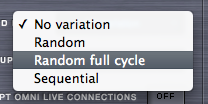
The Round Robin Menu lets you select how Round Robin samples will be ordered when two or more Round Robin samples are loaded into memory.
There are four playback options available on the drop-down menu: No Variation, Random, Random Full Cycle, and Sequential.
NOTE: The Sample Thinning settings located in the Patch Browser’s Lite Version Zoom or the Soundsource Zoom Edit View determine how many Round Robin samples are loaded with the Patch or Soundsource.
Accept Omni TR Connections
![]()
Enabling this option allows Omnisphere to communicate with the Omni TR iPad app. When Accept Omni TR Connections is enabled, Omni TR will be able to automatically connect to Omnisphere when launched.
For complete instructions on setting up Omni TR, please visit our website at: http://www.spectrasonics.net/omni_tr_app/
SYSTEM - Modulation
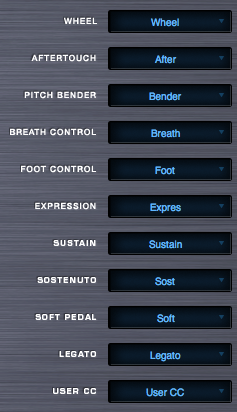
The MODULATION assignments section allows you to override and remap the standard MIDI messages used the Modulation Matrix sources in Omnisphere. Simply select the drop-down menu next to one of the fourteen modulation types and a pop up will appear that says “Move MIDI Controller”. Then on your MIDI controller move the knob, slider or wheel that you wish to use to remap to that Modulation source.
The ‘User CC’ Modulation source is particularly useful for adding an additional, non-standard MIDI Controller into the Omnisphere Modulation Matrix - without disrupting any of the standard assignments.
SYSTEM - MIDI Controller
The choices for MIDI modulation source in Omnisphere include a variety of standard MIDI controllers such as Wheel, Expression, Soft Pedal, etc. You can use these options on the System Page to map those sources to other MIDI controls. This can be useful if you don't have a particular physical controller such as an Expression Pedal. For example, if you map Wheel to Breath Control, you can use a Breath Controller in any patches that use the Wheel as a modulation source.

To re-map any of these controllers, select a menu in the MODULATION column and move the controller that you want to assign to modulation type.
NOTE: The remapped control will only be visible on the System Page. In the Modulation Matrix and Modulation Source menu of the Edit Page the original Modulation Source name will be shown. For this reason, it’s recommended to use the ‘User CC’ source, since that’s not used in any factory patches.
SYSTEM - Master Tuning

This is Omnisphere’s global tuning parameter. That means any tuning change you make on MASTER TUNING will affect any other tuning settings in the instrument. The default is 440Hz, which is the standard for most Western music. For other tuning standards, Omnisphere’s master pitch can be changed to accommodate any of them.
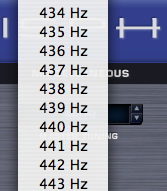
Range – 420Hz-460Hz